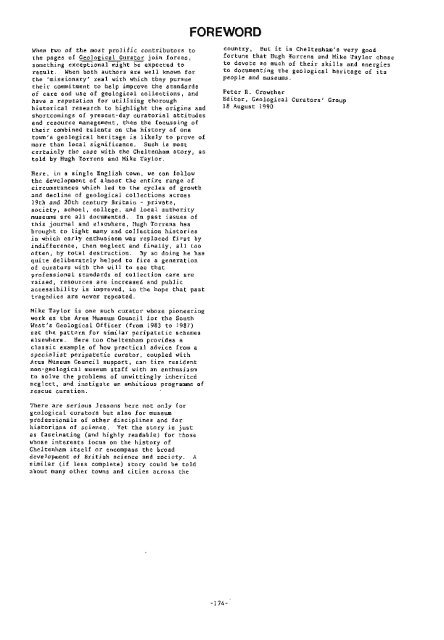Number 5 - Geological Curators Group
Number 5 - Geological Curators Group
Number 5 - Geological Curators Group
You also want an ePaper? Increase the reach of your titles
YUMPU automatically turns print PDFs into web optimized ePapers that Google loves.
When two of the most prolific contributors tothe pages of <strong>Geological</strong> Curator join forces,something exceptional might be expected toresult. When both authors are well known forthe 'missionary' zeal with which they pursuetheir commitment to help improve the standardsof care and use of geological collections, andhave a reputation for utilizing thoroughhistorical research to highlight the origins andshortcomings of present-day curatorial attitudesand resource management, then the focussing oftheir combined talents on the history of onetown's geological heritage is likely to prove ofmore than local significance. Such is mostcertainly the ease with the Cheltenham stary, astold by Hugh Torrens and Mike Taylor.Here, in a single English town, we can followthe development of almost the entire range ofcircumstances which led to the cycles of growthand decline of geological collections across19th and 2Dth century Britain - private,society, school, college, and local authoritymuseums are all documented. In past issues ofthis journal and elsewhere, Hugh Torrens hasbrought to light many sad collection historiesin which early enthusiasm was replaced first byindifference, then neglect and finally, all toooften, by total destruction. By so doing he hasquite deliberately helped to fire a generationof curators with the will to see thatprofessional standards of collection care areraised, resources are increased and publicaccessibility is improved, in the hope that pasttragedies are never repeated.Mike Taylor is one such curator whose pioneeringwork as the Area Museum Council for the SouthWest's <strong>Geological</strong> Officer (from 1983 to 1987)set the pattern for similar peripatetic schemeselsewhere. Here too Cheltenham provides aclassic example of how practical advice from aspecialist peripatetic curator, coupled withArea Museum Council support, can fire residentnon-geological museum staff with an enthusiasmto solve the problems of unwittingly inheritedneglect, and instigate an ambitious programme ofrescue curation.There are serious lessons here not only forgeological curators but also for museumprofessionals of other disciplines and forhistorians of science. Yet the story is justas fascinating (and highly readable) for thosewhose interests focus on the history ofCheltenham itself or encompass the broaddevelopment of British science and society. Asimilar (if less complete) story could be toldabout many other towns and cities across theFOREWORDcountry, But it is Cheltenham's very goodfortune that Hugh Zorrens and Mike Faylor choseto devote so much of their skills and energiesto documenting the geological heritage of itspeople and museums.Peter R. CrowtherEditor, <strong>Geological</strong> <strong>Curators</strong>' <strong>Group</strong>18 August 1990
















